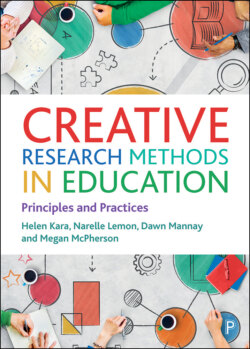Читать книгу Creative Research Methods in Education - Kara Helen - Страница 6
На сайте Литреса книга снята с продажи.
ОглавлениеList of case studies
2.1 Design thinking, ideation and affinity mapping
2.2 Activism with children
2.3 The Alzheimer’s Project
2.4 Kahu and reclamation of Indigenous knowledges
3.1 Walking interview in a library as an informal learning space
3.2 Drawing weekly lived experiences on a postcard
3.3Lectio divina as a way to create meaning of lived experiences
3.4 Dance as a way of knowing
3.5 Hip hop and youth voice
4.1 A living inquiry of digital portfolios for reflection and learning in art education
4.2 Children as digital image makers – photo self-elicitation
4.3 Graphic organisers as part of the curriculum and a data source
4.4 Cartoon storyboards
5.1 The effectiveness of creative LEGO® methods in qualitative interviews
5.2 Modelling ‘professional love’ with LEGO® – engaging youth and community work students
5.3 ‘University Challenge’ – understanding the learning journeys of mature students
5.4 Working collaboratively with visual artefacts for self-study
5.5 Using objects to explore the experiences of undergraduate students
6.1 Embodied analysis
6.2 Visual analysis
6.3 Poetic analysis
6.4 Ethnodramatic writing for analysis
6.5 Ethnodramatic writing and ethnotheatre for analysis
6.6 Ethnotheatre for analysis
6.7 Mixed-methods analysis with different types of data
6.8 Mixed-methods analysis with one type of data
7.1 Using creatively gathered data in research reporting
7.2 Mixing methods within a research report
7.3 Mixed-methods reporting on a research project
7.4 Poetic research reporting
7.5 Research report in comic form
7.6 Collaborative research reporting
7.7 Performative reporting of research
8.1 Video presentation in doctoral education
8.2 Digital storytelling
8.3 Whiteboard animation
8.4 Collaborative presentation – small scale
8.5 Collaborative presentation – large scale
9.1 ‘Only inside the classroom?’ Moving from undergraduate dissertation to academic chapter publication
9.2 The ‘Case of Ethics’ – getting out messages from research
9.3 Public engagement with research using participatory video
9.4 Using artefacts and audio to communicate alternative gender discourses
9.5 Using a multimodal online community of practice to reach diverse audiences
